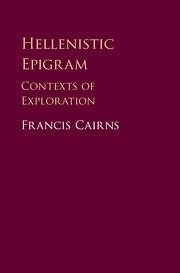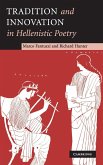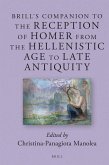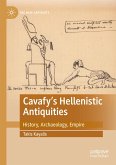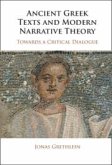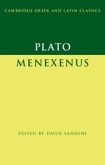Francis Cairns
Hellenistic Epigram
Francis Cairns
Hellenistic Epigram
- Gebundenes Buch
- Merkliste
- Auf die Merkliste
- Bewerten Bewerten
- Teilen
- Produkt teilen
- Produkterinnerung
- Produkterinnerung
Investigates the literary, linguistic, historical, epigraphic, and other contexts of Hellenistic epigrams in themed chapters through analyses of individual epigrams.
Andere Kunden interessierten sich auch für
![Tradition and Innovation in Hellenistic Poetry Tradition and Innovation in Hellenistic Poetry]() Marco FantuzziTradition and Innovation in Hellenistic Poetry140,99 €
Marco FantuzziTradition and Innovation in Hellenistic Poetry140,99 €![Brill's Companion to the Reception of Homer from the Hellenistic Age to Late Antiquity Brill's Companion to the Reception of Homer from the Hellenistic Age to Late Antiquity]() Brill's Companion to the Reception of Homer from the Hellenistic Age to Late Antiquity254,99 €
Brill's Companion to the Reception of Homer from the Hellenistic Age to Late Antiquity254,99 €![Cavafy's Hellenistic Antiquities Cavafy's Hellenistic Antiquities]() Takis KayalisCavafy's Hellenistic Antiquities93,99 €
Takis KayalisCavafy's Hellenistic Antiquities93,99 €![Lucretian Receptions Lucretian Receptions]() Philip HardieLucretian Receptions126,99 €
Philip HardieLucretian Receptions126,99 €![Ancient Greek Texts and Modern Narrative Theory Ancient Greek Texts and Modern Narrative Theory]() Jonas GrethleinAncient Greek Texts and Modern Narrative Theory116,99 €
Jonas GrethleinAncient Greek Texts and Modern Narrative Theory116,99 €![Plato Plato]() Plato128,99 €
Plato128,99 €![The Moon in the Greek and Roman Imagination The Moon in the Greek and Roman Imagination]() Karen Ní MheallaighThe Moon in the Greek and Roman Imagination108,99 €
Karen Ní MheallaighThe Moon in the Greek and Roman Imagination108,99 €-
-
-
Investigates the literary, linguistic, historical, epigraphic, and other contexts of Hellenistic epigrams in themed chapters through analyses of individual epigrams.
Hinweis: Dieser Artikel kann nur an eine deutsche Lieferadresse ausgeliefert werden.
Hinweis: Dieser Artikel kann nur an eine deutsche Lieferadresse ausgeliefert werden.
Produktdetails
- Produktdetails
- Verlag: Cambridge University Press
- Seitenzahl: 532
- Erscheinungstermin: 27. Oktober 2016
- Englisch
- Abmessung: 238mm x 157mm x 33mm
- Gewicht: 857g
- ISBN-13: 9781107168503
- ISBN-10: 1107168503
- Artikelnr.: 45332091
- Herstellerkennzeichnung
- Libri GmbH
- Europaallee 1
- 36244 Bad Hersfeld
- gpsr@libri.de
- Verlag: Cambridge University Press
- Seitenzahl: 532
- Erscheinungstermin: 27. Oktober 2016
- Englisch
- Abmessung: 238mm x 157mm x 33mm
- Gewicht: 857g
- ISBN-13: 9781107168503
- ISBN-10: 1107168503
- Artikelnr.: 45332091
- Herstellerkennzeichnung
- Libri GmbH
- Europaallee 1
- 36244 Bad Hersfeld
- gpsr@libri.de
Francis Cairns held the Chairs of Latin at the University of Liverpool and of Latin Language and Literature at the University of Leeds before moving in 2000 to his present position as Professor of Classical Languages at Florida State University. His earlier books are Generic Composition in Greek and Roman Poetry (1972), Tibullus: A Hellenistic Poet at Rome (Cambridge, 1979), Virgil's Augustan Epic (Cambridge, 1989), Sextus Propertius: The Augustan Elegist (Cambridge, 2006), Papers on Roman Elegy (1969-2003) (2007) and Roman Lyric (2012).
Preface
Abbreviations
Part I. Introductory: Contexts and their Loss: 1. Audience context and circulation context
2. Epigraphic context
3. The state of the text
Part II. Afterlives: 4. Optimism
5. Consolation
6. Pessimism?
7. Shipwrecks
Part III. Philosophical Matters: 8. Over-philosophical interpretations (Callimachus, Asclepiades, Posidippus)
9. Philosophical superficiality (Leonidas)
10. Meleager and philosophy
11. Philodemus
Part IV. Temples and Shrines: 12. A shrine of the Great Mother
13. Apollo's deer at Kourion
14. Paphian Aphrodite
Part V. Literary Polemics: 15. Posidippus
16. Asclepiades on Lyde
17. Further Hellenistic literary programmes
18. Antipater of Sidon
19. Epigrams about Erinna
Part VI. Literary Polemics Continue: 20. Telchines and grammarians
21. Polemic pro/anti epic?
Part VII. Poetry, Sex, the Countryside: 22. Poetry and sex
23. Country matters
Part VIII. Medical Connections: 24. Medicine in non-epigrammatic Hellenistic poetry
25. Medicine in epigram
Part IX. Epitaphs: Epigraphic or Epideictic?: 26. Death caused by wine
27. Deaths while drunk
28. Deaths of drunken old women
29. Cenotaphic epitymbia
Part X. Local Interests: 30. Archaizing language: Anyte and Nicias
31. Dialects
32. Local customs: hair dedications
33. Historical claims: the Thyreatis
Part XI. Speakers, Addressees, Antecedents: 34. Geese taken for swans
35. Speakers and addressees in archaic inscribed epigrams
36. Epitymbic speakers and addressees
37. Unsafe assumptions of originality
38. Over-interpretations of Hellenistic epigrams
Part XII. The Erotic: 39. Novelty in the erotic komos
40. Legalism
41. 'Enrichment' and emotion
42. Cynical attitudes and mercenary motives
43. Meleager and mosquitoes
Part XIII. Generic Innovation: 44. Implicit dialogue
45. Explicit dialogue
46. Initial generic deception
47. Epigraphic genres in amatory epigrams
48. Function as context
49. Multiple addressees
Part XIV. Learning: 50. Philological
51. Technical
52. Metrical
53. Mythography and local culture
Bibliography
Index locorum
Index anthologiae graecae
Index of personal names in epigrams
General index.
Abbreviations
Part I. Introductory: Contexts and their Loss: 1. Audience context and circulation context
2. Epigraphic context
3. The state of the text
Part II. Afterlives: 4. Optimism
5. Consolation
6. Pessimism?
7. Shipwrecks
Part III. Philosophical Matters: 8. Over-philosophical interpretations (Callimachus, Asclepiades, Posidippus)
9. Philosophical superficiality (Leonidas)
10. Meleager and philosophy
11. Philodemus
Part IV. Temples and Shrines: 12. A shrine of the Great Mother
13. Apollo's deer at Kourion
14. Paphian Aphrodite
Part V. Literary Polemics: 15. Posidippus
16. Asclepiades on Lyde
17. Further Hellenistic literary programmes
18. Antipater of Sidon
19. Epigrams about Erinna
Part VI. Literary Polemics Continue: 20. Telchines and grammarians
21. Polemic pro/anti epic?
Part VII. Poetry, Sex, the Countryside: 22. Poetry and sex
23. Country matters
Part VIII. Medical Connections: 24. Medicine in non-epigrammatic Hellenistic poetry
25. Medicine in epigram
Part IX. Epitaphs: Epigraphic or Epideictic?: 26. Death caused by wine
27. Deaths while drunk
28. Deaths of drunken old women
29. Cenotaphic epitymbia
Part X. Local Interests: 30. Archaizing language: Anyte and Nicias
31. Dialects
32. Local customs: hair dedications
33. Historical claims: the Thyreatis
Part XI. Speakers, Addressees, Antecedents: 34. Geese taken for swans
35. Speakers and addressees in archaic inscribed epigrams
36. Epitymbic speakers and addressees
37. Unsafe assumptions of originality
38. Over-interpretations of Hellenistic epigrams
Part XII. The Erotic: 39. Novelty in the erotic komos
40. Legalism
41. 'Enrichment' and emotion
42. Cynical attitudes and mercenary motives
43. Meleager and mosquitoes
Part XIII. Generic Innovation: 44. Implicit dialogue
45. Explicit dialogue
46. Initial generic deception
47. Epigraphic genres in amatory epigrams
48. Function as context
49. Multiple addressees
Part XIV. Learning: 50. Philological
51. Technical
52. Metrical
53. Mythography and local culture
Bibliography
Index locorum
Index anthologiae graecae
Index of personal names in epigrams
General index.
Preface
Abbreviations
Part I. Introductory: Contexts and their Loss: 1. Audience context and circulation context
2. Epigraphic context
3. The state of the text
Part II. Afterlives: 4. Optimism
5. Consolation
6. Pessimism?
7. Shipwrecks
Part III. Philosophical Matters: 8. Over-philosophical interpretations (Callimachus, Asclepiades, Posidippus)
9. Philosophical superficiality (Leonidas)
10. Meleager and philosophy
11. Philodemus
Part IV. Temples and Shrines: 12. A shrine of the Great Mother
13. Apollo's deer at Kourion
14. Paphian Aphrodite
Part V. Literary Polemics: 15. Posidippus
16. Asclepiades on Lyde
17. Further Hellenistic literary programmes
18. Antipater of Sidon
19. Epigrams about Erinna
Part VI. Literary Polemics Continue: 20. Telchines and grammarians
21. Polemic pro/anti epic?
Part VII. Poetry, Sex, the Countryside: 22. Poetry and sex
23. Country matters
Part VIII. Medical Connections: 24. Medicine in non-epigrammatic Hellenistic poetry
25. Medicine in epigram
Part IX. Epitaphs: Epigraphic or Epideictic?: 26. Death caused by wine
27. Deaths while drunk
28. Deaths of drunken old women
29. Cenotaphic epitymbia
Part X. Local Interests: 30. Archaizing language: Anyte and Nicias
31. Dialects
32. Local customs: hair dedications
33. Historical claims: the Thyreatis
Part XI. Speakers, Addressees, Antecedents: 34. Geese taken for swans
35. Speakers and addressees in archaic inscribed epigrams
36. Epitymbic speakers and addressees
37. Unsafe assumptions of originality
38. Over-interpretations of Hellenistic epigrams
Part XII. The Erotic: 39. Novelty in the erotic komos
40. Legalism
41. 'Enrichment' and emotion
42. Cynical attitudes and mercenary motives
43. Meleager and mosquitoes
Part XIII. Generic Innovation: 44. Implicit dialogue
45. Explicit dialogue
46. Initial generic deception
47. Epigraphic genres in amatory epigrams
48. Function as context
49. Multiple addressees
Part XIV. Learning: 50. Philological
51. Technical
52. Metrical
53. Mythography and local culture
Bibliography
Index locorum
Index anthologiae graecae
Index of personal names in epigrams
General index.
Abbreviations
Part I. Introductory: Contexts and their Loss: 1. Audience context and circulation context
2. Epigraphic context
3. The state of the text
Part II. Afterlives: 4. Optimism
5. Consolation
6. Pessimism?
7. Shipwrecks
Part III. Philosophical Matters: 8. Over-philosophical interpretations (Callimachus, Asclepiades, Posidippus)
9. Philosophical superficiality (Leonidas)
10. Meleager and philosophy
11. Philodemus
Part IV. Temples and Shrines: 12. A shrine of the Great Mother
13. Apollo's deer at Kourion
14. Paphian Aphrodite
Part V. Literary Polemics: 15. Posidippus
16. Asclepiades on Lyde
17. Further Hellenistic literary programmes
18. Antipater of Sidon
19. Epigrams about Erinna
Part VI. Literary Polemics Continue: 20. Telchines and grammarians
21. Polemic pro/anti epic?
Part VII. Poetry, Sex, the Countryside: 22. Poetry and sex
23. Country matters
Part VIII. Medical Connections: 24. Medicine in non-epigrammatic Hellenistic poetry
25. Medicine in epigram
Part IX. Epitaphs: Epigraphic or Epideictic?: 26. Death caused by wine
27. Deaths while drunk
28. Deaths of drunken old women
29. Cenotaphic epitymbia
Part X. Local Interests: 30. Archaizing language: Anyte and Nicias
31. Dialects
32. Local customs: hair dedications
33. Historical claims: the Thyreatis
Part XI. Speakers, Addressees, Antecedents: 34. Geese taken for swans
35. Speakers and addressees in archaic inscribed epigrams
36. Epitymbic speakers and addressees
37. Unsafe assumptions of originality
38. Over-interpretations of Hellenistic epigrams
Part XII. The Erotic: 39. Novelty in the erotic komos
40. Legalism
41. 'Enrichment' and emotion
42. Cynical attitudes and mercenary motives
43. Meleager and mosquitoes
Part XIII. Generic Innovation: 44. Implicit dialogue
45. Explicit dialogue
46. Initial generic deception
47. Epigraphic genres in amatory epigrams
48. Function as context
49. Multiple addressees
Part XIV. Learning: 50. Philological
51. Technical
52. Metrical
53. Mythography and local culture
Bibliography
Index locorum
Index anthologiae graecae
Index of personal names in epigrams
General index.

